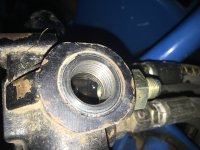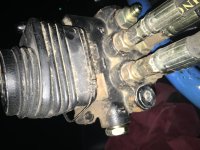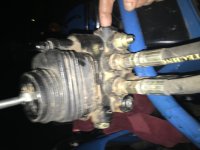Called bailey hydraulics this morning. they say the t port will need to be plugged for double acting cylinder N port is return (weird) so let me know if im thinking wrong here. my loader valve has the power beyond on the right where its plugged on the side? return port is plugged on the left? so can I run the return out of the new valve into the port on the left on the FEL valve and supply from plugged port on the right? Thanks guys!
You are using an out of date browser. It may not display this or other websites correctly.
You should upgrade or use an alternative browser.
You should upgrade or use an alternative browser.
chief p-80 single spool help
- Thread starter Ricard
- Start date
- Views: 7536
/ chief p-80 single spool help
#11
LD1
Epic Contributor
I am thinking you need a new valve.
Dont see anything that indicates that valve is capable of power-beyond.
Perhaps call baileys and ask them if the valve is capable of power beyond. Because you NEED that to feed whatever your current loader PB is feeding.
Flow path of your current tractor is most likely like this
Pump>Loader valve>PB out of loader valve to 3PH
you need to insert this valve between the loader valve and 3PH
So it will go like this
Pump>Loader valve>PB out of loader valve to inlet of new valve>Pb out of new valve to 3PH (or wherever the PB line was going off the loader valve.
Basically unhook the PB line off the loader valve. That PB port on the loader valve NOW needs to feed the inlet of the new valve. The POWER BEYOND outlet of the new valve needs to hook back to the line that WAS on the PB of the loader.
THEN you need a 3rd line that can TEE into any return line on the tractor.
Dont see anything that indicates that valve is capable of power-beyond.
Perhaps call baileys and ask them if the valve is capable of power beyond. Because you NEED that to feed whatever your current loader PB is feeding.
Flow path of your current tractor is most likely like this
Pump>Loader valve>PB out of loader valve to 3PH
you need to insert this valve between the loader valve and 3PH
So it will go like this
Pump>Loader valve>PB out of loader valve to inlet of new valve>Pb out of new valve to 3PH (or wherever the PB line was going off the loader valve.
Basically unhook the PB line off the loader valve. That PB port on the loader valve NOW needs to feed the inlet of the new valve. The POWER BEYOND outlet of the new valve needs to hook back to the line that WAS on the PB of the loader.
THEN you need a 3rd line that can TEE into any return line on the tractor.
power beyond from loader valve is blocked off with a plug on the right of valve (I think). the loader valve only has a supply, 4 working lines to the loader and a return line going back to the tank, and 2 plugged ports one on the left side and one on the right. the 3 point feeds off of the weird looking valve on top of the transmission housing that feeds straight from the pump mounted on the engine block by the radiator. hope this helps explain whats going on. these tractors where not originally equipped with loaders this is all after market other than the 3 point. new valve is not PB capable. it only has a supply port, 2 working ports, T port which bailey is telling me is only for 3 way operation single acting cylinder and needs to be blocked and the N port which they say is my actual return port for 4 way or double acting cylinder.
LD1
Epic Contributor
Then your loader valve is the only valve in the circuit. And with only one valve, NO PB is required.
If 3PH is fed elsewhere, great.
You need to add a single valve in the circuit, to have two valves total.....your loader valve and your new chief.
Only one needs to have PB. And that needs to be the first valve.
Since your chief valve dont have PB, Then just supply it off the PB that is plugged on the loader valve, and return to tank as normal.
Just make sure you have the correct PB adapter for your loader valve to supply the new valve.
If 3PH is fed elsewhere, great.
You need to add a single valve in the circuit, to have two valves total.....your loader valve and your new chief.
Only one needs to have PB. And that needs to be the first valve.
Since your chief valve dont have PB, Then just supply it off the PB that is plugged on the loader valve, and return to tank as normal.
Just make sure you have the correct PB adapter for your loader valve to supply the new valve.
LD1
Epic Contributor
That just sounds way to simple, maybe i was making this harder than it was. thanks LD1 and for everyone else's advice as well. nice to have a place to find answers!
Just make sure you have the right PB plug for the loader valve.
It isnt as simple as removing the plug thats in there now.
There is usually a cartridge type adapter that threads in that port, that you would then thread a new hose into. It isolates the PB and Tank passages from one another. Because if not using PB, those passages are common, and a simple plug to block off the extra port is all that is needed.
When actually using PB, that passage needs separated, and thus the adapter. If you simply take the plug out and put a hose where the plug is currently, you will have two "tank" lines instead of a separated tank and PB port.
oldnslo
Super Member
I found this document on the net. I can not see where it states if power beyond is an option for the P80. Since it has the "N" port it might be. The larger question is does the existing FEL valve have Power beyond capabilities. In looking at the pictures I only see six hoses connected to the valve.
Attachments
you are correct, the new valve does not have a PB. the FEL valve I think does but am not certain. this all confuses me. I took the plugs out of the blocked ports last night and what I found was the pressure line on the right (line removed with fitting in place) shares an open port where my finger is that has a plug in it. port on the left is an open port that shares an open path with the plug that is in place on the left. sorry guys im still a bit confused on this, so is the port on the right that is plugged considered a PB port. PB is what im confused with my return I understand. thank you guys!
LD1
Epic Contributor
Usually valves have two options for locating the pressure line. The one not used is to be plugged. You cannot use a second line where that plug is, because that would be like putting a tee in a pressure line, which don't work on open center systems. Only closed center systems.
Power beyond is totally different than anything you have on your tractor now, so I'll do my best to explain the theory, and hope you grasp:
Power beyond is for running multiple separate valves in a open center circuit.
Your current loader valve is a single valve. So it isn't utilizing any power beyond. It simply has pressure in, return to tank, and work ports that actuate the loader.
As it is, when NOT using the loader, the oil simply passes, unrestricted, in the p (pressure) port, and back out the t (tank) port.
When you move the joystick, it opens p to a work port. Let's say A. And work port B is open back to tank now. So as the cylinder extends by pumping oil to the cylinder via the A port.....the oil returning out the other end of the cylinder returns, unrestricted, back through the B port and to tank.
Now let's say you need to put a second valve in the system as you want. Well you simply cannot tee into a pressure line. Because oil takes the path of least resistance. And if you have a tee, both valves, being open center freely flow oil back to tank when not being used. And if you want to operate a valve, it will never make pressure because oil will freely flow through the second valve back to tank and nothing will happen.
Understand up to this point?
So we have ruled out tapping into P port for a second valve.
What about T port?
Well most valves, the T port isn't rated for more than a few hundred pounds of pressure. You can crack a casting, or blow the case seals out around the spools, and remember, when using the loader valve, the work ports need an unrestricted path back to tank to return oil from the one side of the cylinder.
So tank port is a no-go. Clear to this point?
So now what,?
Enter the realm of power beyond. ,(PB)
A power beyond circuit separates the tank passage of the current valve into two flow paths. One that is designed for system pressure, to feed more valves. One that is low pressure, designed to handle work ports return flow.
So when NOT using the loader valve pressure still comes in via the P port, but no longer exits via the low pressure T passage. Rather it exits the PB port and feeds your next valve... Which if being used you have full system pressure at your disposal. If not being used, it simply returns to tank via the tank port of the NEW valve since it's open center.
If you choose to use the loader valve, to raise your loader for instance, pressure comes in the P port. Whatever flow is required (varies if you are feathering the valve to control speed) goes out the A work port to extend the cylinders. Oil returning from that cylinder travels back through B port, and out the tank port, unrestricted. Whatever remaining system flow coming in the P port, that isn't being used by the loader valve, goes out the PB to the second valve. If the second valve isn't being used it simply returns to tank. If the second valve is also trying to be used, whatever flow you have available will be used to cycle the grapple at full system pressure.
So you see, tank and PB are two separate things.
If there is no second valve....there is no PB. And the passageways in the valve are common and a simple plug to block off the second port is all you have. That second port is nothing more than a second Tank port at the moment.
If you simply remove the plug, it would be like teeing into a tank like, which we have established, simply won't work.
What you need is what is called a power beyond adapter specifically for your loader valve. It is more than just a plug. It actually extends down into that power beyond port, and separates the tank and PB passage ways, which right now are common.
Once you remove that plug, and install the PB adapter, you need a hose from there to the inlet (p) of the new valve.
The T of the new valve just returns to tank and can be tee'd into any existing tank line, or the case itself.
And think you can figure out what to do with the work ports of the new valve
Clear as mud?
Power beyond is totally different than anything you have on your tractor now, so I'll do my best to explain the theory, and hope you grasp:
Power beyond is for running multiple separate valves in a open center circuit.
Your current loader valve is a single valve. So it isn't utilizing any power beyond. It simply has pressure in, return to tank, and work ports that actuate the loader.
As it is, when NOT using the loader, the oil simply passes, unrestricted, in the p (pressure) port, and back out the t (tank) port.
When you move the joystick, it opens p to a work port. Let's say A. And work port B is open back to tank now. So as the cylinder extends by pumping oil to the cylinder via the A port.....the oil returning out the other end of the cylinder returns, unrestricted, back through the B port and to tank.
Now let's say you need to put a second valve in the system as you want. Well you simply cannot tee into a pressure line. Because oil takes the path of least resistance. And if you have a tee, both valves, being open center freely flow oil back to tank when not being used. And if you want to operate a valve, it will never make pressure because oil will freely flow through the second valve back to tank and nothing will happen.
Understand up to this point?
So we have ruled out tapping into P port for a second valve.
What about T port?
Well most valves, the T port isn't rated for more than a few hundred pounds of pressure. You can crack a casting, or blow the case seals out around the spools, and remember, when using the loader valve, the work ports need an unrestricted path back to tank to return oil from the one side of the cylinder.
So tank port is a no-go. Clear to this point?
So now what,?
Enter the realm of power beyond. ,(PB)
A power beyond circuit separates the tank passage of the current valve into two flow paths. One that is designed for system pressure, to feed more valves. One that is low pressure, designed to handle work ports return flow.
So when NOT using the loader valve pressure still comes in via the P port, but no longer exits via the low pressure T passage. Rather it exits the PB port and feeds your next valve... Which if being used you have full system pressure at your disposal. If not being used, it simply returns to tank via the tank port of the NEW valve since it's open center.
If you choose to use the loader valve, to raise your loader for instance, pressure comes in the P port. Whatever flow is required (varies if you are feathering the valve to control speed) goes out the A work port to extend the cylinders. Oil returning from that cylinder travels back through B port, and out the tank port, unrestricted. Whatever remaining system flow coming in the P port, that isn't being used by the loader valve, goes out the PB to the second valve. If the second valve isn't being used it simply returns to tank. If the second valve is also trying to be used, whatever flow you have available will be used to cycle the grapple at full system pressure.
So you see, tank and PB are two separate things.
If there is no second valve....there is no PB. And the passageways in the valve are common and a simple plug to block off the second port is all you have. That second port is nothing more than a second Tank port at the moment.
If you simply remove the plug, it would be like teeing into a tank like, which we have established, simply won't work.
What you need is what is called a power beyond adapter specifically for your loader valve. It is more than just a plug. It actually extends down into that power beyond port, and separates the tank and PB passage ways, which right now are common.
Once you remove that plug, and install the PB adapter, you need a hose from there to the inlet (p) of the new valve.
The T of the new valve just returns to tank and can be tee'd into any existing tank line, or the case itself.
And think you can figure out what to do with the work ports of the new valve
Clear as mud?




